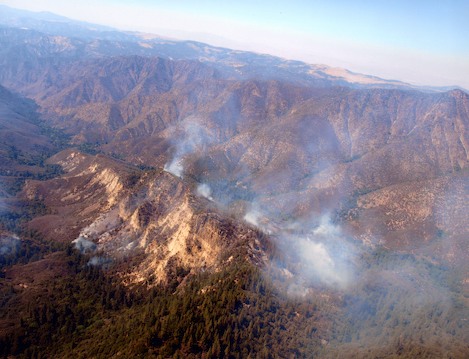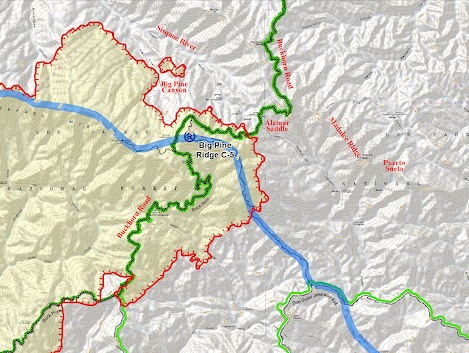Major Fire Battle Looms This Weekend
Next Few Days Will be Critical in Stopping Zaca Fire Advance

While the Zaca Fire continues to smolder in Buckhorn Canyon, fire fighters have had an additional two or three days to button up the southwest sections of the fire line, complete burn outs there and build additional containment line.
“We really needed those days to get ready for when the fire in Buckhorn Canyon heats up,” John Estes, a Section Operation Chief for the Type 1 National Interagency Management Team explained. “There really aren’t any easy points we can work from once the fire starts moving down towards Mono Creek.”

View Large Map
Pointing to the operations map taped to the outside of the trailer that operations uses to plan strategy, he added, “It’s a hodge podge of ridges that go in every direction, lots of places for the fire to move. We’ve got to fight it ridge by ridge.
Currently hot shots are busy working at clearing brush just south of the fire line along a jeepway known as Camuesa Road. Firefighters hope to use the Camuesa Ridge, immediately south of the jeepway, as an anchor they can use to turn the fire. If successful, the hope is the fire will start a more pronounced eastward movement down the jeepway into Indian Creek and begin turning back to the north so it heads up Indian and Mono Canyons.
“It won’t be easy,” Estes added. “If the fire reaches the point where Indian and Mono Creeks join, it could just as easily continue downstream as up. The difference may be what the winds are like at the time.”
More may be known after today’s fire activity. Once the fire reached the bottom of the Buckhorn drainage, it began the uphill run to the south that worried fire command, but it also began to hook upward to the north as well as to the east where it is nearing the Pie Canyon jeepway that marks the western edge of the Dick Smith Wilderness. With favorable wind flows the fire could actually redirect itself.
If not, and the fire moves out of Buckhorn Canyon to the south, the fire line will be moving directly down into the Camuesa Creek drainage where the hot shots are hard at work. Immediately south of that is Camuesa Ridge, roughly set as the twenty-four hour trigger.
Wilderness Fire Lines Unstaffed
On the northern and eastern parts of the fire lines, the fire continues to burn unchecked. More than 25 miles of uncontained fire line remain along the upper parts of Buckhorn Road and along the upper Sisquoc but as in Buckhorn Canyon, the fire is moving slowly. This will change as the flames hit canyon bottoms and begin uphill runs.

View Large Map
Because almost all of the fire lines are within the wilderness areas and much of it in almost inaccessible locations, efforts on the north side of the fire are focused on securing the Sierra Madre ridge and a line on the northeast that goes from Santa Barbara Canyon along Dry Canyon, just west of Cuyama Peak and then down Tinta Canyon on an OHV route to Highway 33. It appears now that if the fire wishes, it will burn much of the Dick Smith Wilderness.
An example of the type of area in which the fire is burning is the section of Big Pine Canyon shown below. Though it is burning slowly, there is almost no way hot shot crews can be positioned safely in this area, almost no way they can clear wide enough spaces to prevent blow overs and no positions from which they can work with air attack to anchor a point and turn the fire.

“I fully expect to be here until the start of October,” one of the contract workers told me. “Even if we hold the Santa Ynez River, there is a lot of work that needs to be done in the wildernesses.”
Author’s Note
Due to the number of comments this story has generated, I thought I’d add a footnote regarding use of air attack. First, it’s important to understand that aircraft don’t put out fires, notwithstanding having the Pacific ocean at our doorstep.
What air attack can do is slow a fire down so the dozers, hand crews and other ground support troops can manage the fire. In a sense, what air attack does is buy the ground forces time to go direct on the fire line.
Another issue is the coordination of air attack; in a focused area where a fire threatens to breach a line, only so many planes and helicopters can be in the air. Several thousand feet above the fray, the movement of the planes is being directed by air command. There is a limit to the number of aircraft that can be directed from above and move in and out of a specific location.
One person asked why we don’t nuke it with the DC-10 since it can drop up to 20,000 gallons of Phos-Chek at a time. The Incident Commander, John Molumby explained, “You’ve got a plane capable of laying out a mile long layer of retardant. There aren’t many places here that we could get the hand crews in after a drop that long.”
On another track, the fixed wing aircraft now fly out of Santa Maria The switch was made from Santa Barbara to the north county about two months ago. Heli-attack is based in the valley at Rancho San Fernando Rey – which means they can be up and on the job and we wouldn’t know it here.
Last – though we might want to have all of the resources for our own fire – all fire resources are managed in California from one of two centers. When our local IC orders planes or helicopters the request is measured against requests from other fires – and there is some huge ones in Montana right now.



